Throwback Thursday: Curiosities of bygone days

Our Throwback Thursday this week is taken from issue 28 of the printed edition of Genizah Fragments, published in October 1994, by J.D. Pearson, Emeritus Professor of Bibliography at the University of London. He recalls his days as a young man in Cambridge, fetching manuscripts, encountering Genizah researchers, and battling the smells of the fragments:
Having joined the Library staff as a “boy” (today called an assistant) in 1928, at the age of sixteen, I became acquainted with the documents from the Genizah in about 1930, when I was transferred to Room Theta. My principal duties were to fetch “special order” books and manuscripts from the closed parts of the Library for readers in Theta, which was the precursor of the present West Room in the Library’s former location, to the west of the Senate House and the Old Schools. Room Theta led off from Room Lambda, where the reference books were housed. This was approached from Cockerell's Building, now the Squire Law Library.
The Taylor-Schechter Collection – which had no specific Library staff to oversee it – was kept in the Cairo Room, underneath Room Theta and more or less adjacent to the gateway in Trinity Lane, which leads to the University offices in the Old Schools. Apart from the few bound volumes and the documents encased in glass, most of the fragments, which represented less than a quarter of what is now available, were loosely contained in large green boxes, many in a rather dilapidated condition.
The boxes were brought up to Room Theta to be ransacked by Hebrew scholars who, then as now, descended on Cambridge during the Long Vacation. I recall that Yefim Schirmann, of Berlin and then Jerusalem, and Solomon Skoss, of Dropsie College, Philadelphia, were frequent visitors. Professor Jacob Mann, with his research on the Collection, was a tradition even then.
Away from the Library for some six years, as an undergraduate and Browne Memorial Student, I was appointed in 1938 Under-Librarian in the Oriental Section and eventually succeeded E. J. Thomas in that area. By then, the Library had moved across the river to its present location; the Taylor-Schechter Collection was housed on a floor under the Anderson Room. Don Crane and I began to note references to the Genizah documents in published works and to attempt to identify some of the printed items.
Among the curiosities I remember, from those and subsequent days, were a photograph of Professor Mann in a home-made gas mask – to prevent the foul odours caused by the long interment of the documents from reaching his nostrils; Schechter’s letter to Mrs Lewis announcing, with great excitement, his discovery of the Hebrew text of Ecclesiasticus and proposing to visit her at 11 that evening to explain it to her; and a papyrus of several sheets folded over and stitched down the middle. This was taken apart and put between glass, for its better preservation, at the request of Dr J. L. Teicher, Lecturer in Rabbinics.
In the 1950s, Professor Shelomo Dov Goitein learned of the existence of many thousands of other fragments (now known as the New Series), which had been set aside by the original sorters of the material as thought to be of lesser importance and interest. Goitein managed to persuade the University Librarian, A. F. Scholfield, that these should be brought to light; but before being made generally available to readers, they had to be decontaminated. To achieve this, the fragments were placed for a time on the rafters underneath the roof of the North Front until all foul odour was dissipated.
When I left Cambridge for the School of Oriental and African Studies in London, most of the fragments had yet to be conserved. At that time, there were few lists of their contents, and no staff had yet been appointed to deal specifically with the Collection.
What happened next? The manuscripts are no longer odiferous and unconserved. Henry Knopf was made responsible for the Taylor-Schechter manuscripts 1965, and on his resignation, Stefan Reif was appointed in 1973. At Reif’s urging, in 1974 the University Library agreed to establish the Genizah Research Unit, and the work of conserving the manuscripts and producing catalogues and bibliographical records began in earnest. Read more about the early years of the Genizah Research Unit in Rebecca Jefferson’s article “Thirty Years of The Taylor-Schechter Genizah Research Unit”, in The Written Word Remains: The Archive and the Achievement – Articles in Honour of Professor Stefan C. Reif, edited by Shulie Reif, Cambridge University Library (February, 2004), pp. 9–27.

Add new comment